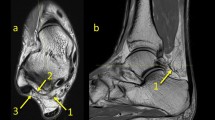Abstract
Background
The Lisfranc ligament is important in supporting the arch of the foot. Injury to this ligament causes pain and deformity of the foot.
Methods
We studied the Lisfranc ligament and its surrounding anatomical structures in detail, and examined the route for reconstruction and the thickness of the ligament for optimum reconstruction. 78 feet of 39 cadavers were used for systematic dissection. Of the cadavers 17 were males and 22 were females; their ages ranged from 60 to 99 years (mean age 84.5 years).
Results
The Lisfranc ligament is a fasciculated interosseous ligament that binds the lateral surface of C1 and the medial surface of M2. It has one to four fasciculi; the mean number of fasciculi is 2.0 and the cross-sectional area is 88 mm2. The ideal reconstruction is such that the center of the ligament is positioned 5.9 mm distally from the C2–M2 joint surface on M2, and at a position 8.6 mm centrally from the C1–M1 joint surface on C1. The reconstruction would also be ideal if positioned at the same level as the C2–M2 joint surface on C1, horizontal to the plantar surface from the medial surface of C1 toward M2. This is the route for anatomical reconstruction of the Lisfranc ligament.
Conclusion
Our results reveal some important aspects of anatomical and physiological ligament reconstruction.







Similar content being viewed by others
References
de Palma L, Santucci A, Sabetta SP, Rapali S. Anatomy of the Lisfranc joint complex. Foot Ankle Int. 1997;18:356–64.
Leibner ED, Mattan Y, Shaoul J, Nyska M. Floating metatarsal: concomitant Lisfranc fracture-dislocation and complex dislocation of the first metatarsophalangeal joint. J Trauma. 1997;42:549–52.
Sangeorzan BJ, Veith RG, Hansen ST. Jr. Salvage of Lisfranc’s tarsometatarsal joint by arthrodesis. Foot Ankle. 1990;10:193–200.
Vuori JP, Aro HT. Lisfranc joint injuries: trauma mechanisms and associated injuries. J Trauma. 1993;35:40–5.
Nunley JA, Vertullo CJ. Classification, investigation, and management of midfoot sprains: Lisfranc injuries in the athlete. Am J Sports Med. 2002;30:871–8.
Raikin SM, Elias I, Dheer S, Besser MP, Morrison WB, Zoga AC. Prediction of midfoot instability in the subtle Lisfranc injury. Comparison of magnetic resonance imaging with intraoperative findings. J Bone Joint Surg Am. 2009;91:892–9.
Min JH, Kang SH, Lee JB, Cho TH, Suh JG. Anatomic analysis of the transforaminal ligament in the lumbar intervertebral foramen. Neurosurgery. 2005;57:37–41.
Davies MS, Saxby TS. Intercuneiform instability and the “gap” sign. Foot Ankle Int. 1999;20:606–9.
Kuo RS, Tejwani NC, Digiovanni CW, Holt SK, Benirschke SK, Hansen ST, Jr, et al. Outcome after open reduction and internal fixation of Lisfranc joint injuries. J Bone Joint Surg Am. 2000;82-A:1609–18.
Solan MC, Moorman CT 3rd, Miyamoto RG, Jasper LE, Belkoff SM. Ligamentous restraints of the second tarsometatarsal joint: a biomechanical evaluation. Foot Ankle Int. 2001;22:637–41.
Conflict of interest
The authors declare that they have no conflict of interest.
Author information
Authors and Affiliations
Corresponding author
Additional information
Study Designs: Descriptive Laboratory Study-Anatomy in vitro.
About this article
Cite this article
Hirano, T., Niki, H. & Beppu, M. Anatomical considerations for reconstruction of the Lisfranc ligament. J Orthop Sci 18, 720–726 (2013). https://doi.org/10.1007/s00776-013-0416-z
Received:
Accepted:
Published:
Issue Date:
DOI: https://doi.org/10.1007/s00776-013-0416-z




